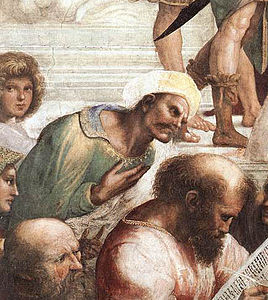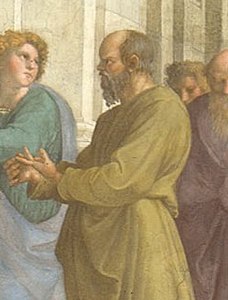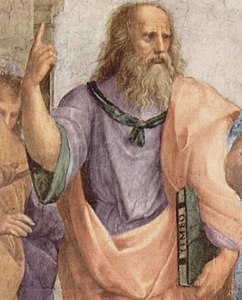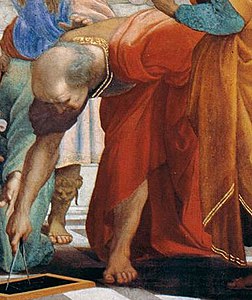The school of Athens

|
| The school of Athens |
|---|
| Raphael , 1510 to 1511 |
| fresco |
| Raphael Rooms |
The School of Athens ( La scuola di Atene in Italian ) is a fresco by the painter Raphael , which he made for Pope Julius II from 1510 to 1511 in the Stanza della Segnatura of the Vatican (originally the hall for signing in the private rooms of the Pope) . The image is part of a cycle, in addition to the School of Athens the Parnassus which Disputa of the Blessed Sacrament ( Disputation of the Holy Sacrament ) and the Cardinal and God's virtues is. The title of the picture refers to the outstanding philosophical school of thought of ancient Greece , embodied by its forerunners, main representatives and successors. The focus is on the philosophers Plato and Aristotle . In the spirit of the Renaissance, the fresco glorifies ancient thought as the origin of European culture, its philosophy and sciences.
The paintings
The picture, which is about 7.70 m wide at its greatest, shows a monumental interior with a central perspective , in which a gathering of important scientists and philosophers from antiquity to the Renaissance takes place. The Platonic minds are grouped on the left, the Aristotelian-oriented minds on the right. In the background are the philosophical representatives, in the foreground the scientists, mathematicians and artists. The title The School of Athens was first mentioned by Giovanni Pietro Bellori in 1695.
Aristotle, holding his ethics in his hand, uses a horizontal gesture to point to an ethical organization of the world . Plato, Timaeus in one hand and the other raised vertically , symbolizes the movement of the sensual world into an ideal principle . Opposite the fresco is the Disputa del Sacramento , also painted by Raphael. Both images represent a summary of ancient and Christian, Aristotelian and Platonic thoughts of a world.
The box for The School of Athens is kept in the Pinacoteca Ambrosiana in Milan . The figure of Pensieroso (Heraklit), seated at the table in the foreground, is missing from the cardboard and was added to the fresco afterwards by removing the wall covering at this point and reapplying it.
According to Giorgio Vasari , The School of Athens was the first fresco that Raphael made for Julius II. The Pope was so enthusiastic about the work that he had the work of other artists interrupted in the rooms and commissioned Raphael to furnish them alone. However, this chronology is controversial in research and is only partially confirmed by the results of the last restoration.
The people pictured
There is no uniform doctrine about the assignment of the figures shown. Depending on the author, the interpretations differ from one another or indicate several possible people for the same figure. The central figures (nos. 14 and 15) as Plato and Aristotle are undisputed . According to the art historian Luitpold Dussler , only the depictions of Socrates , Pythagoras , Euclid , Ptolemy , Zarathustra , Raphael , Sodoma and Diogenes are considered certain. Further allocations are only of a speculative nature. The more recent research contradicts Dussler on this point.
The most common assignments of the characters to characters in the story, some of which are controversial:
- Zeno of Kition (founder of the Stoic School)
- Epicurus (founder of the Epicurean school)
- Federico II Gonzaga (Duke of Mantua )
- Assignment not clear: Boëthius , Anaximander or Empedocles
- Averroes (Arabic philosopher and theologian)
- Pythagoras (mathematician), the youth next to Parmenides (assignment not confirmed)
- Alkibiades (politician and general from Athens)
- Assignment not clear: Xenophon (historian and biographer of Socrates) or Antisthenes
- Assignment not clear: Hypatia or Francesco Maria I. della Rovere
- Assignment not clear: Aeschines or Xenophon
- Assignment not clear: Parmenides (philosopher, founder of the Eleatic School) or Euclid (mathematician)
- Socrates (philosopher and teacher of Plato)
- Heraclitus (philosopher, embodied by Michelangelo )
- Plato with the script Timaeus (philosopher, embodied by Leonardo da Vinci )
- Aristotle with the writing Nicomachean Ethics (philosopher and student of Plato)
- Diogenes (philosopher and cynic )
- Assignment not clear: Plotinus (philosopher) or Aristarchus of Samos (astronomer and mathematician)
- Assignment not clear: Euclid or Archimedes (mathematician, embodied by Bramante )
- Assignment not clear: Zarathustra (Persian religious founder) or Seleucus of Babylon (astronomer)
- Ptolemy (astronomer and geographer)
- Assignment not clear: Protogenes or Copernicus
The figure with the letter R is considered to be a representation of Raphael. On the neckline of Euclid's robe are the letters RVSM, which are interpreted as the signature of the artist ( Raffael urbinas sua manu ). According to further interpretations, the old man with a green cloak and stick in the upper right margin is said to be Kleanthes , a philosopher of the Stoa , who had Aristarchus standing next to him put on trial for ungodliness.
- The School of Athens - Assignments
See also: Sistine Madonna , Platonic Academy , Raphael Rooms
reception
A section of the picture served as a template for the record covers of the albums Use Your Illusion I and II by the American hard rock band Guns N 'Roses . The fresco was also shown modified in the music video of "Tessellate" by the British alternative pop band Alt-J . In contrast to the original, instead of the philosophers, “ gangsta ” are shown here, who have a similar constellation and attitude to one another. The motif also served as a template for 100 Years of Film by Renato Casaro , with film characters shown here.
The picture is also the motif of a tapestry that has adorned the front of the plenary chamber of the French National Assembly since 1879 .
literature
- Ernst Gombrich : The symbolism of Raffael's 'Stanza della Segnatura'. In: Ernst Gombrich: On the art of the Renaissance. Volume 2: The symbolic image. Klett-Cotta, Stuttgart 1986, ISBN 3-608-76147-0 , pp. 104-124.
- Marcia Hall (Ed.): Raphael's "School of Athens". Cambridge University Press, Cambridge et al. 1997, ISBN 0-521-44899-9 .
- Guerino Mazzola among others: Raster image - image raster. Springer-Verlag, Berlin et al. 1986, ISBN 3-540-17267-X .
- Glenn W. Most : Raffael. The school of Athens. About reading the pictures (= Fischer 13385 feat ). Fischer-Taschenbuch-Verlag, Frankfurt am Main 1999, ISBN 3-596-13385-8 .
- Arnold Nesselrath : Raphael's School of Athens. (= Recent Restorations of the Vatican Museums. Volume I). Edizioni Musei Vaticani, Vatican City 1997, ISBN 88-86921-05-2 .
- Konrad Oberhuber : Polarity and Synthesis in Raphael's “School of Athens”. Urachhaus, Stuttgart 1983, ISBN 3-87838-379-7 .
- Frank Keim: New Recognitions in the School of Athens, in: ders. Venus, Jupiter and Co. - The great astronomers of the Renaissance, Hamburg 2018, ISBN 978-3-339-10220-1 ( https://www.verlagdrkovac.de /978-3-339-10220-1.htm ).
Web links
- Overall picture and partial pictures with comments on the individual persons
- Stanze di Raffaello (Vatican Museums)
Remarks
- ↑ Georg Kauffmann (ed.): The art of the 16th century . (= Propylaea art history. Volume 8). Berlin 1970, DNB 457857021 , p. 162.
- ^ Luitpold Dussler: Raffael. Bruckmann, 1966, pp. 73f.
- ↑ a b c d e Matthias Schulz: Riddle from the Renaissance . In: Der Spiegel . No. 6 , 2009, p. 128-129 ( online ).
- ↑ Michel Mopin: L'Assemblée nationale et le Palais Bourbon - d'hier à aujourd'hui. (= Connaissance de l'Assemblée. N ° 10). 1998, II. § 3.













